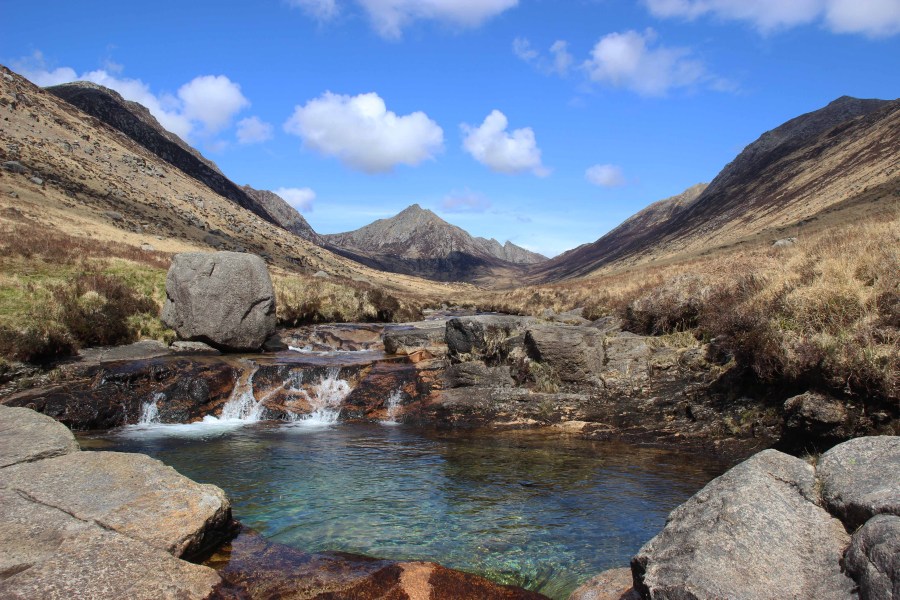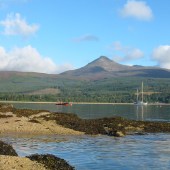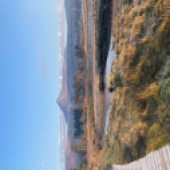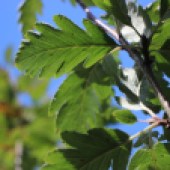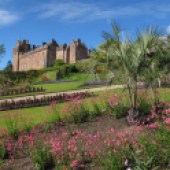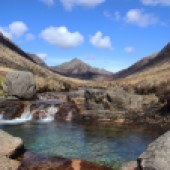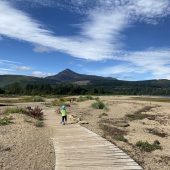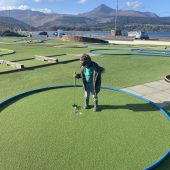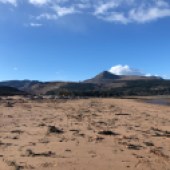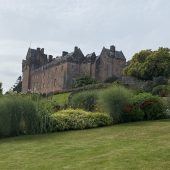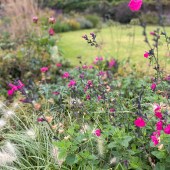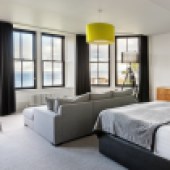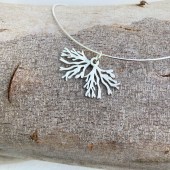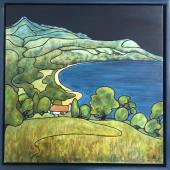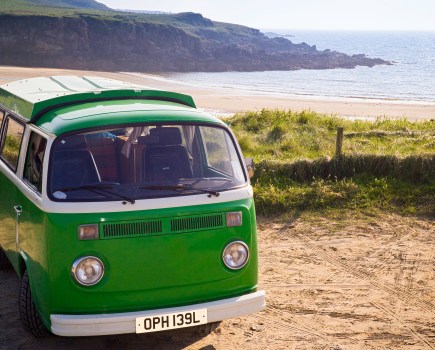The Isle of Arran’s main village basks between mountains and beach, radiating a seaside vibe that combines art, botany and wildlife, reveals EMILY ROSE MAWSON, as she spends the weekend in Brodick.
You’ll never forget the view as you sail into the port of Brodick. The Scottish Isle of Arran’s main village lies where the depths of the Firth of Clyde segue into a mile-long sandy crescent sheltered by pointy summits. They rear up from gentle folds of farmland, suddenly topping out on the pyramidal peak of Goat Fell at 2,867 feet, and are scythed open here and there by deep glens.
Tightly packed cottages and villas dating from the 1920s and ’30s line the south side of the bay, facing the red sandstone turrets of Brodick Castle that protrude from towering pine trees on the opposite shore.
Brodick is an hour’s ferry crossing from Ardrossan on the mainland, itself an hour from Glasgow, but this scenery is unexpected. As a result of the Highland Boundary Fault, which cuts the island in two, Arran is often dubbed ‘Scotland in miniature’. It has a mountainous Highlands-like top and an agricultural Lowlands-like bottom, with Brodick, a lively seaport, situated just about in the middle, along the narrow 55-mile road that encircles the island.
The village largely developed after the first pier was built in 1872 but the area has been settled for thousands of years. Nearby you’ll find evidence of Iron Age hill forts (including a very scenic one at Dun Fionn) and cup-and-ring marks carved into rocks (at Stronach Wood above the bay). But it was the Vikings who gave the place its name when they sailed their longships into the deep sheltered crescent in the 9th century and declared it Breda Vick (broad bay).
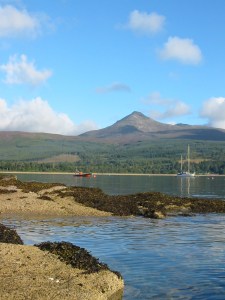
To soak it all in, I follow the Fisherman’s Walk Circuit, an easy 3½-miler that starts at the end of the promenade near the ‘wee’ Co-op. It starts on boardwalk that weaves across tidal plains beside the golf course towards Goat Fell. It’s delightful to watch the grey seals cavorting in the water, and cormorants and oystercatchers foraging the shoreline. They’re part of a crowd of local wildlife that also includes golden eagles and adders in the surrounding glens – both species that are protected by law as they are in decline elsewhere in Britain.
Soon, you pass the lane to Arran Heritage Museum – a good stop-off for anyone interested in the fascinating local history and geology. Its Geohub reveals why the island is a source of excitement among geologists near and far: there’s achingly pretty North Glen Sannox, a few miles further north, which has examples of pillow lavas from the Ordovician age, thought to represent remnants of ocean crust from the continental collision. And it was on the coast in Lochranza, at Arran’s north end, where newer rocks are laid on top of older, that the 18th-century Scottish geologist James Hutton proved the earth was billions, not thousands, of years old.
Set in a former croft, the museum also has fantastic recreations of a 19th-century cottage, blacksmith’s shop and a 1940s schoolroom, and displays on farming, social history and the Clearances. I head for its tearoom, Café Rosaburn, to recharge with a wedge of chocolate, banana and coconut loaf – irresistible; the place does some of the best baking in Brodick.
As you continue along the Fisherman’s Walk via beach and road, you eventually reach Home Farm, once the castle’s estate farm, now home to businesses such as Arran Cheese Shop and ARRAN Sense of Scotland, stocking toiletries inspired by the landscape – think fragrances such as gorse and sea air.
But first comes Cladach, where burn estuaries once welcomed cargo vessels, passenger boats and the postal ship to the site of the original village. Nowadays, the hamlet is home to Isle of Arran Brewery, renowned for its beer and real ale; Saltwater Gallery, in the former laundry building for Brodick Castle, specialising in contemporary seascapes; and Arran Botanical Drinks, serving seasonal cocktails in a beach bar setting.
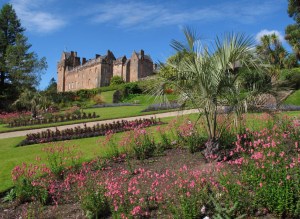
It’s also the gateway to the main route up Goat Fell, on a well-made path that climbs consistently for around five hours and is worth it in good weather for the views across the Kilbrannan Sound to the Paps of Jura and the Firth of Clyde to the Isles of Cumbrae and Bute.
“The northern mountains of Arran are formed by hard granite, sculpted by glaciers that have carved sweeping glens with sharp, rugged ridges,” explains National Trust for Scotland senior ranger Kate Sampson, who looks after the land around Goat Fell and runs guided walks. “This diversity of landscape supports numerous habitats, which in turn support a diversity of wildlife and plants.”
She recommends walking up Glen Rosa, which is in easy reach of Cladach. In May the glen is covered in bluebells, and if you look carefully, you may see the beautiful green hairstreak butterflies. You can also look out for golden-ringed dragonflies and heath spotted orchids, sweet-scented bog myrtle and the endemic Arran Whitebeams – some of the rarest trees in the world.
Another good place to explore Arran’s spectacular botanic diversity, which thrives thanks to the island’s unique microclimate, are the sea-view gardens at Brodick Castle. The weird and wonderful plants include spiky Puya berteroniana, native to the mountains of Chile, whipcord cobra lily from the Himalayas, and giant vipers-bugloss, reaching 20 feet tall, from the Canary Isles, as well as three National Collections of rhododendrons with giant waxy teardrops of leaves.
Many of these rare specimens were acquired in the 1920s by the 6th Duchess of Montrose, Lady Mary Louise Hamilton, who bought shares in plant-hunting expeditions to unexplored corners of the world. For centuries the castle was the strategic seat of the Dukes of Hamilton, but the present building took shape in 1844 and is now owned by the National Trust for Scotland.
It is lined with valuable artefacts, including a fantastic collection of 18th and 19th century works by artists such as Jean Antoine Watteau, Thomas Gainsborough and John Fredrick Herring that are an important part of the lively local art scene.
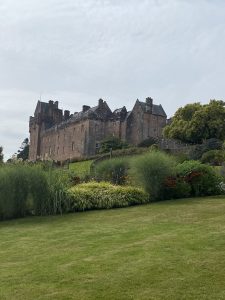
Views from the castle’s south-facing perch are commanding, and on the sunny day I visit, when the sea twinkles turquoise, the scene recalls the Balearics. So, when Kate Sampson says that on Arran, “you have the lot, and all within easy reach”, she’s right.
This tranquillity is 20 minutes’ walk from the promenade – broad and bustling, with the buzz of a busy seaport for most of the summer. It’s always fun to play mini golf, operated by the Taste of Arran Shop on the seafront (it also stocks produce such as creamy Arran Cheese and Wooleys of Arran oatcakes).
Strike out shopping afterwards: nearby are the boutique Driftwood, which sells covetable coastal interior items, and Arran Active, an award-winning family-owned outdoors store where you can also hire paddle boards, as well as James of Arran, a fantastic chocolate shop that handmakes high-cocoa-content creations. For a more active afternoon, there’s a bike hire shed – lots of visitors like to cycle the coast road – or for relaxation, the spa with swimming pool at Auchrannie Resort, which also has two hotels.
“In the evenings there is great pub entertainment,” says Sheila Gilmore, CEO of Visit Arran and Development Manager of the Arran Trust. She recommends the Ormidale Hotel, The Douglas, or Brodick Bar, part of the fine dining restaurant Brodick Brasserie. Sheila adds: “Sometimes you can catch a concert at Brodick Hall with Music Arran, part of the Arran Theatre and Arts Trust. It’s always a lovely experience that brings together lots of people of different ages and makes for an eclectic and enthusiastic audience.”
With luck your weekend will feature a Brodick sunset – and that you’ll never forget, either. I settle onto my seaside bench and gaze at it through half-closed eyes, watching as the coast turns soft gold. At sea, lights twinkle here and there on cargo ships sheltering overnight in the bay, and the sun blazes as it sinks behind the mountains, smudging definition from the rockfaces.
A WALK OF ART
Ann Hume is a Brodick-based jeweller who draws inspiration from the world around her. Here she shares the best of the village’s arts scene.
What can visitors expect from the arts in Brodick?
I’d recommend following the Arran Arts Heritage Trail, with sandstone plinths celebrating artists who have been inspired by Arran’s landscape. In Brodick the featured artist is Craigie Aitcheson, whose plinth is on the seafront facing Goat Fell. At Arran Heritage Museum there is a second plinth celebrating the potter Hugh Purdie, along with a permanent display of his work. There’s also the Arran Art Trail, which takes in three stunning studios in Brodick.
Which are your favourite arts outlets?
I often visit Saltwater Gallery at Cladach for its eclectic mix of work, mainly inspired by the sea. I also like painter Angela Elliott Walker’s studio (appointment only) – her works have beautiful colour, lines and shapes inspired by island days. Then there are Tim Pomeroy’s sculptures in Brodick Castle grounds, which I admire for their monumentality and delicate detail inspired by natural forms. But the best of it is Arran Open Studios, when over 30 studios open their doors to the public each August.
Where do you go in Brodick for inspiration?
Each morning I take a walk along Cladach beach and sit near the old boathouse, watching the changing light and listening to the peaceful sound of the sea.
WHERE TO STAY
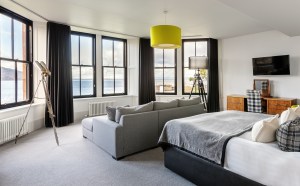
With deep bay windows overlooking the ferry terminal and bay, The Douglas Hotel is a C-listed, 18th-century sandstone affair that once welcomed submariners who came to train in the waters of the Clyde.
Stylishly renovated with nods to its surroundings, such as a dusky palette of island-inspired tones with accents of tartan and tweed, it is suave, but comfortable and welcoming. Book the top-floor suite if you can (it comes with its own private balcony commanding a sweeping vista of the bay).
But all the rooms are spacious and nicely done out, featuring super-king-sized beds with luxurious mattress toppers. The hotel also has a bistro and bar, and outdoor terraces with that beautiful sea view.
DINE IN STYLE
FOR BREAKFAST…
With a port-side perch, coastal styling of white and royal blue, and a counter full of homemade cakes, Little Rock has all the trappings of the seaside café. It opens at 9am daily, serving breakfast options such as the ‘Arran Brekkie’ of Arran Butcher’s links sausages with black pudding and tattie scones from Wooley’s, the Arran bakery on the seafront.
The cafe is run by husband-and-wife duo Ailie and Chris, who with their friendly team offer some of the best service in town. There’s a dog-friendly section and a deli selling produce from independent wholesalers.
FOR LUNCH…
The Wineport occupies an unmissable candy pink manor at Cladach that was the old traveller’s inn. These days it’s popular with hikers fresh off Goat Fell. For lunch, the locally sourced menu might feature smoked salmon salad from Skipness Smokehouse in Argyll, beetroot bhaji with tzatziki, or smoked mackerel pate and Arran oaties. In fine weather there’s a sun-drenched garden to enjoy.
FOR DINNER…
Facing Brodick’s sandy beach, The Parlour dishes up stone-baked, hand-thrown, sourdough pizzas with all the classic toppings on a sauce infused with extra virgin olive oil.
Enjoy the cafe-bar interior or get a takeout to savour by the sea. Follow up with a scoop of Arran Ice Cream, available at the counter in flavours such as toffee fudge and Brodick brulee.

